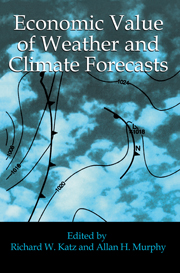6 - Forecast value: prototype decision-making models
Published online by Cambridge University Press: 27 October 2009
Summary
Introduction
In this chapter, theoretical relationships between the scientific quality and economic value of imperfect weather forecasts are considered. Prototype decision-making models are treated that, while relatively simple in structure, still capture some of the essential features (e.g., the “dynamics”) of real-world situations. The emphasis is on analytical results that can be obtained concerning the structure of the optimal policy and the shape of the “quality/value curve.” It is anticipated that knowledge of such theoretical properties for prototype models will provide insight into analogous properties for real-world decision-making problems that are inherently much more complex.
The prospects for increases in the quality of weather forecasts in the future have been discussed in Chapter 1 of this volume, thereby providing a partial justification for the hypothetical increases in forecast quality that are assumed in the present chapter. Various aspects of forecast quality (e.g., bias and accuracy) have been described in Chapter 2. A simplified form of weather information is treated here in which a one-dimensional measure of quality can be defined that is synonymous with the concept of sufficiency (also described in Chapter 2). The Bayesian decision-theoretic approach to assessing the economic value of imperfect information is adopted, an approach that has been introduced in Chapter 3. Analytical results obtained for prototype decision-making models are compared with those for real-world case studies that have also employed this prescriptive approach to real-world decision-making problems (reviewed in Chapter 4). Reasons for the underutilization (or nonoptimal use) of existing weather forecasts have been outlined in Chapter 5, and some explanations for such behavior based on theoretical considerations are presented here.
- Type
- Chapter
- Information
- Economic Value of Weather and Climate Forecasts , pp. 183 - 218Publisher: Cambridge University PressPrint publication year: 1997
- 21
- Cited by



